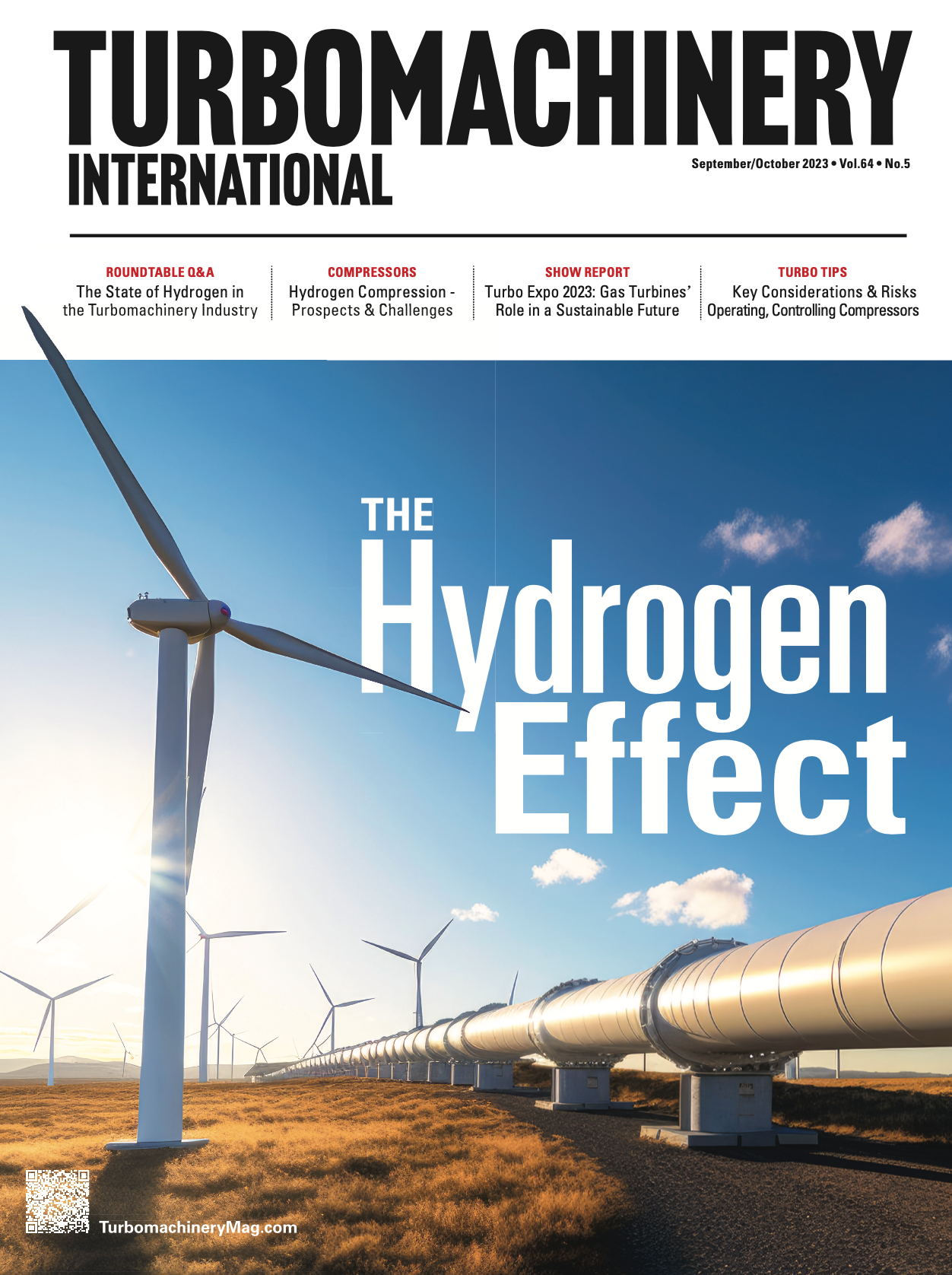Part 1: Roundtable Q&A: The State of Hydrogen in the Turbomachinery Industry
A roundtable of experts and OEMs addresses hydrogen’s role in the energy landscape, including supply and demand, opportunities, and obstacles.
As hydrogen continues to dominate discussions about energy security and decarbonization, conference agendas, and government climate goals, its role and capacity are often misrepresented and overhyped. According to the International Energy Agency’s (IEA) Global Hydrogen Review 2022, more than 80% of hydrogen is derived from fossil fuels, with some experts placing it higher. Further, the main uses of hydrogen in the industry are to produce ammonia—which accounts for 34 Mt of hydrogen demand—methanol (15 Mt), and direct reduced iron in the steel industry (5 Mt). Most importantly, almost all hydrogen used in the industrial sector is produced from unabated natural gas or coal, which translates to 630 Mt of direct CO2 emissions. These numbers complicate the carbon-neutral image of hydrogen.
While the technology is proven, hydrogen still plays an insignificant role in the power generation sector, accounting for 0.2% of the total generation, according to IEA. Solutions are underway, but most say it will be at least 10 years for green hydrogen to make deep headway in power generation. IEA reported that 2021 was a record year in electrolysis deployment, with more than 200 MW of additional installed capacity, three times more than 2020, bringing the total operational capacity above 500 MW. But carbon capture, utilization, and storage (CCUS) associated with hydrogen production has been largely stagnant. IEA reported in 2021, 0.6 Mt of hydrogen were produced from fossil fuels with CCUS, capturing roughly 10 Mt—the same production and capture level as in 2020, as no new projects started operation.
To elaborate on these numbers, facts, and technologies, Turbomachinery International put together this roundtable of industry insiders to offer their points of view and insights into hydrogen’s current and projected role in the energy sector.
ROUNDTABLE PANEL:
Mark Axford
Founder
Axford Turbine Consultants
Klaus Brun
Global Director of R&D
Ebara-Elliott Energy Company
Alex Habeder
Head of Business Strategy
Sustainable Energy Systems
Siemens Energy
Andreas Kramer
Senior Manager Business Development
MAN Energy Solutions
Daniel Patrick
Market Manager Hydrogen
Atlas Copco Gas and Process
Q: HOW REALISTIC IS IT TO COUNT ON HYDROGEN AS THE “GOLDEN TICKET” TO NET-ZERO EMISSIONS IN TERMS OF COST, SUPPLY, AND IMPLEMENTATION?

MARK AXFORD: Net-zero emissions are normally discussed to be achieved within a timetable—often 2050. I do not see hydrogen as the golden ticket primarily because green hydrogen is far too expensive compared to other competing technologies. In 2022, the worldwide industrial demand for hydrogen was 95 million metric tonnes—almost half of the demand was fulfilled by manufacturing hydrogen by reforming methane gas, i.e., grey hydrogen.
In the United States, the industrial price of grey hydrogen is $1 per kg delivered. The cost to make green hydrogen utilizing an electrolyzer is $5 per Kg. To encourage the production of green hydrogen, the United States and the European Union have passed legislation to subsidize its production. The U.S. subsidy is a “double dip”. First, $3 per Kg for all the green hydrogen produced plus an additional guaranteed payment for the electricity produced from it as it is put into fuel cells or gas turbines. There is no market for green hydrogen without huge government subsidies. Moreover, there is no way to discern $5 green hydrogen from $1 grey hydrogen; they are physically identical. Safeguards must be put in place to prevent large-scale fraud.
There are also technical issues with hydrogen relating to the cost of storing and transporting it. Most of the large U.S. interstate pipelines could safely transport hydrogen or a blend of hydrogen and natural gas. However, the pipeline compressor stations would require major rework to handle the volumetric changes due to mole weight. A bigger problem exists in the gas distribution pipelines networks and end-user appliances like stoves and furnaces. Much of the smaller diameter piping could suffer embrittlement if exposed to hydrogen. Also, most end-user devices would not operate if the hydrogen component of the fuel was more than a few percent.

KLAUS BRUN: Hydrogen is not a golden ticket to net zero. It is one of many enabling technologies that can, if properly applied and deployed, provide a positive contribution toward a net-zero or decarbonized energy economy. Hydrogen is not a fuel source. It is a basic chemical element that can be utilized for energy storage and transport. Since it does not release CO2 in a net-positive energy exothermic reaction, it is a viable energy carrier. However, hydrogen does not occur naturally and, thus, it needs to be produced either through electrolysis or partial oxidation reactions. Both processes are energy-intensive and require expensive equipment and new infrastructure. Hydrogen is not an easy gas to handle in that it is highly explosive, has a wide flammability range, leaks easily, causes embrittlement in many metals, and is hard to compress since it is a very light gas. Thus, the practical usage of hydrogen is limited to those applications where an industrial process requires hydrogen as a precursor product (such as refining or fertilizer production) or to an application where energy cannot be viably stored or transported by other cheaper and safer means, i.e., hydrogen as an energy carrier is only practical when energy that is produced cannot otherwise be transported easily (via an electrical grid), stored in batteries or other energy storage devices, or locally consumed.

ALEX HABEDER: While hydrogen holds promise for achieving net-zero emissions, relying solely on it as the “golden ticket” for cost-effective and scalable implementation creates challenges. The two most significant challenges are (1) hydrogen must become a closed commercial business model that enables worthwhile private commercial investments, and (2) at the same time, we must enter series production with supply chains and suppliers—the majority of whom are still manufacturers.
The cost of hydrogen production today, particularly from renewable sources, remains relatively high compared to traditional fossil-fuel alternatives. While new technologies and economies of scale are emerging and expected to drive down costs over time, achieving cost competitiveness with fossil fuels will require substantial investment and innovation. The development of fossil fuel prices also plays a role, especially with regard to the price of CO2.
Scaling up hydrogen production and ensuring a reliable supply pose logistical challenges and require substantial infrastructure development. Although hydrogen is an established chemical feedstock in the industrial sector, using green hydrogen in the energy sector is relatively new; thus, there’s no established infrastructure for green hydrogen. We will need robust supply chains, production capacities, or transportation networks to promote the use of green hydrogen on a large scale. All of this must be created at a speed that can keep pace with an announced market ramp-up.
"The cost of hydrogen production today remains relatively high compared to traditional fossil-fuel alternatives. While new technologies and economies of scale are expected to drive down costs over time, achieving cost competitiveness with fossil fuels will require substantial investment and innovation." - Alex Habeder
Transitioning to a hydrogen-based economy necessitates extensive changes across sectors and the widespread adoption of hydrogen technologies. A comprehensive approach integrating it with other decarbonization solutions is crucial to leverage hydrogen effectively. We need large-scale kick-start projects to test the technologies and progress from talking to acting. Speed is also of the essence.
In these areas, there is no doubt that low-carbon hydrogen is the path to decarbonization: replacing grey hydrogen as feedstock in the chemical and fertilizer industry and changing steel production to the direct reduction pathway with low-carbon hydrogen. On the other hand, in terms of mobility, shipping and aviation cannot be easily electrified and need fuels synthesized from clean hydrogen and carbon, such as CO2.

ANDREAS KRAMER: To produce green hydrogen, there is a need for renewable energy in large and sufficient quantities. Without the establishment of regulatory frameworks, the feasibility of implementation becomes questionable. Moreover, industries require investment security to proceed. Additionally, cost reduction through economies of scale must be achieved. Without meeting these prerequisites, relying on hydrogen as the ultimate solution may not be realistic.

DANIEL PATRICK: Hydrogen is an excellent choice to decarbonize certain industries. However, it is just one of the many strategies we will need to deploy to reach net-zero targets. Industries such as material handling, heavy-duty transportation, long-duration energy storage, stationary power generation, and combustion applications (such as green steel) all seem to be attractive sectors for the early implementation of hydrogen.
Q: WHAT ARE SOME OPPORTUNITIES CREATED BY HYDROGEN UTILIZATION IN THE ENERGY INDUSTRY?
AXFORD: Utilizing hydrogen as an energy storage technology requires substantial economic subsidy. Today, the most economical forms of energy storage are coal piles, oil tanks, and LNG tanks. Of course, these are all hydrocarbons and out of favor politically. So, what are the least expensive non-hydrocarbon forms of energy storage? Pumped storage on rivers and lakes has been utilized for decades, but most of the good sites have already been built out. More recently, lithium-ion batteries, similar to automotive battery packs, have become a favorite. Batteries can soak up the excessive quantities of electricity produced by wind turbines and solar panels during peak production hours. Subsidies for battery storage have been generous and batteries can provide instantaneous injection of KW into the grid when needed—a valuable technical feature.
As I see it, if we set aside hydrocarbon energy storage, hydrogen must compete with battery storage. However, lithium-ion battery technology is expensive and not necessarily the best battery technology for long-term bulk storage. Several other battery technologies that are now being tested could bring about a sharp reduction in the installed cost per MWh of battery storage—companies such as Form Energy, EOS, and Zinc8. Toyota has also recently announced a solid-state battery breakthrough. I anticipate a disruptive battery technology will emerge for bulk-energy storage over the next two years that will cause severe damage to hydrogen storage's economic viability.
BRUN: The primary opportunities for hydrogen utilization, with the aim to decarbonize the total energy supply, are in the areas of petrochemical production—the replacement of blue/brown/black hydrogen with green hydrogen—as a transportation fuel, for fertilizer and ammonia production, and for other industrial chemical processes that require hydrogen as a precursor supply. The usage of hydrogen for power generation makes less sense since the cost of converting green electricity to hydrogen and then back to electric power is expensive, and the roundtrip efficiency of this process is well below 40%. It is not logical to use a process that wastes well over 60% of the produced energy to reduce carbon emissions. For curtailed green electricity it makes more sense to try to improve the distribution system to find off-takers for the electricity or to utilize energy storage technologies with higher roundtrip efficiencies, such as pumped hydro, pumped heat, compressed air, liquid air, etc.
HABEDER: Switching from coal to natural gas for power generation and improving efficiency are the first steps to reducing CO2 emissions. Next is substituting sustainable hydrogen for natural gas to enable carbon-neutral power plant operation, since hydrogen combustion does not produce CO2. Combined- and simple-cycle plants provide residual load for periods of low renewable generation and enable large-scale, seasonal storage of renewable electricity. In the long term, hydrogen-fueled gas turbines and combined-cycle plants will enable a fully decarbonized energy system in which renewables form the backbone of all energy consumed.
KRAMER: Currently, hydrogen is predominantly used in refineries and ammonia production via the steam methane reforming process where 1 ton of hydrogen causes 10 tons of CO2 emission. Future advancements aim to replace fossil-fueled power plants with hydrogen-based alternatives, such as power plants utilizing hydrogen, ammonia (produced with green hydrogen), or synthetic fuels (produced with green or blue hydrogen and CO2 from emitting industries like cement). Co-firing of ammonia or methanol in coal-based or combined-cycle gas turbine power plants is also planned. The same applies to large ship engines for ocean-going vessels, which can be fueled by methanol or, in the future, by ammonia (Power-to-X).
PATRICK: The most obvious opportunity for the energy industry is the chance to reduce the carbon footprint of a traditionally carbon-intensive sector and do so by enabling a low-carbon hydrogen economy. Also, the hydrogen economy will create a variety of new jobs, all while leveraging the wealth of knowledge and experience the energy industry has acquired over the decades from working with traditional energy sources.
Click here to read Part 2: Roundtable Q&A: Obstacles Preventing Large-scale Implementation of Hydrogen
Click here to read Part 3: Roundtable Q&A: Turbomachinery and Hydrogen, Ammonia's Role as a Less Carbon-Intensive Fuel Source
